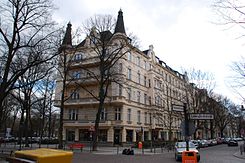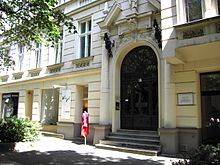Fasanenplatz
| Fasanenplatz | |
|---|---|
| Place in Berlin | |
 The Fasanenplatz |
|
| Basic data | |
| place | Berlin |
| District | Wilmersdorf |
| Created | 1870 |
| Confluent streets |
Schaperstrasse, Ludwigkirchstrasse, Meierottostrasse |
| use | |
| User groups | Pedestrians , cyclists , road traffic |
The Fasanenplatz is located in the Berlin district of Wilmersdorf . The Schaperstrasse, the Ludwigkirchstrasse and the Meierottostrasse flow there. The Fasanenstrasse crosses it.


It was built in 1870 by Johann Anton Wilhelm von Carstenn as a north-western representation and jewelry square in the " Carstenn figure " designed by him , an urban ensemble that includes the Nürnberger , Prager and Nikolsburger Platz . The back of the Joachimsthal Gymnasium has been on its eastern edge since 1880 . A former teacher's house is still on the site today and is now used as a daycare center. The square was given its current name in November 1901. During this time, buildings in the style of the late Wilhelminian era were erected and a central island with lawn and trees was laid out.
During the Second World War , bombing and fire destroyed the northern and western perimeter buildings except for the teacher's house. As part of the International Building Exhibition in 1984 , the square was redesigned: the roundabout was abolished, the square was pedestrianized by paving and provided with wooden benches. On the north side, the architect Gottfried Böhm built a seven-storey building with domed bay windows . On May 31, 1989, a water stele made of stainless steel and glass by the artist Rolf Lieberknecht was set up. These measures gave the square a character with a higher value to stay and became a counter-image to functionalist and car-friendly urban development .
Many artists and intellectuals lived on Fasanenplatz and in the surrounding streets. The most prominent residents at the square were the writer Gerhart Hauptmann and the President of the Poetry Section of the Prussian Academy of the Arts , Heinrich Mann . Hauptmann lived there in the mid-1890s in what is now house 39 Fasanenstrasse, Mann lived a few steps south, in house Fasanenstrasse 61, from 1932 to 1933. He frequented the nearby nightspots, where he met the animator Nelly Kroeger , whom he married in 1939. A few meters north of the square, the writer Arno Holz lived from 1893 to 1896.
In March 1955 the Galerie Bremer opened on Fasanenplatz , whose asymmetrical back room bar designed by Hans Scharoun became a meeting point for artists and journalists. Regular guests were Bernhard Heiliger , Heinz Trökes , Friedrich Luft and Lothar Loewe .
In the late 1960s, Fasanenplatz was a popular meeting place for the so-called " hash rebels " with the scene meeting place Unfathomable Shelter for travelers .
literature
- Fred Oberhauser, Nicole Henneberg: Literary Guide Berlin . with numerous illustrations, maps and registers. Insel, Frankfurt aM, Leipzig 1998, ISBN 3-458-33877-2 .
Web links
- Fasanenplatz. In: Street name lexicon of the Luisenstädtischer Bildungsverein (near Kaupert )
- Fasanenplatz in the district lexicon at berlin.de
- Kai Ritzmann: Cocktails in the shelter of freedom of thought
Individual evidence
- ↑ Bommi Baumann , Günter Langer: Bodo, the “super culture” athlete. SDS website. Retrieved February 16, 2011
Coordinates: 52 ° 29 ′ 54.9 " N , 13 ° 19 ′ 37.7" E